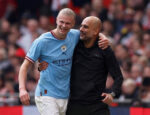Capello’s departure just 4 months before a major tournament leaves a lot to be desired, and a bad taste in the mouth too. Whatever the reasons behind the reasons for his departure are, the presented facts are that Capello spoke out against the FA’s decision feeling that he had been undermined and declaring that he did not agree with the decision. Not wanting to try and read between the lines or speculate on national characteristics or personal attitudes and working relationships, the facts are that Capello has gone.
Looking back at his tenure, it’s difficult to sum up in simple terms. Yes, he has the highest win percentage of any England manager ever, but he also presided over the debacle of the 2010 World Cup, which was statistically England’s worst ever. Alf Ramsey won a lower percentage of games, but crucially won the World Cup in 1966. Bobby Robson has a lower win percentage than Steve McLaren, but is far more fondly remembered because he led the team to an agonising semi-final exit at Italia 90 whereas McLaren will be remembered for his humbling failure to reach Euro 2008. Performances when it counts is what a legacy is founded on. Fabio Capello England reign will most likely be remembered as a failure then, because of the dismal display in South Africa and quite frankly humiliating destruction by the hosts.
It is often said that more is learnt in defeat than in victory – ergo, Capello should only be considered a true failure if lessons from South Africa 2010 were not heeded. The most stark lesson was that the 4-4-2 was dead in the water on the international stage. So long the English national team’s bedrock and point of reference, its default and natural state; the 4-4-2 was demolished in 270 soul-destroying and 90 breathtaking minutes.
Indications are that, yes, lessons were learnt by Capello. He played England in a 4-4-2 just three times in the fifteen games since the World Cup (Admittedly winning all three).
When Capello was appointed, much was made of his disciplinarian nature – this was the man to break the dressing-room cliques, pop the inflated egos and crush player power. This was the man who dropped Beckham at Madrid, the man who had managed some of the greatest names in football’s illustrious history whilst in Italy and Spain, one of the most decorated managers in the domestic game. He did that to some extent, but not everyone got the message. John Terry’s failed revolution was, well… revolting.
He was also heralded as the manager to bring England up to date tactically. People must have forgotten his glory years at Milan were largely based on a 4-4-2 formation, and he played that same formation at Juventus and Real Madrid. Tactical innovator? Perhaps not. But he is a master at creating tactical systems to suit his playing staff. The perennial problem of managing a national side is an extrapolation of the old adage “you can chose your friends but you can’t chose your family” – Capello couldn’t buy Sergio Busquets from Spain, or Messi from Argentina, or Ozil from Germany; he had to work with what he had at his disposal. For a nation of footballers whose very bread and butter had been 4-4-2 since childhood, it would be tough to get those players to adapt.
A loss to France in his second game in charge when deploying his team in a 4-2-3-1 prompted a return to 4-4-2, and after winning two friendlies against USA and Trinidad using 4-4-2, Capello fell short again with a 4-2-3-1 by drawing with Czech Republic. The remainder of 2008 went well for Capello’s 4-4-2, in the next five games he only once deviated to a 4-3-3 against Kazakhstan winning 5-1 and the other four games were victories too. The final game in 2008 was a 2-1 win over a German team who were learning their own lessons in time for 2010.
Capello played 4-4-2 six times in his first year in charge – resulting in six wins out of six.
In 2009, Capello’s second year in charge of England, he suffered an educational defeat at the hands of a very proficient Spanish side (This defeat would be used as a benchmark against which a later victory would be compared – as evidence of progress) and this prompted a big change in tactics. The next six games were played using the popular and modern 4-2-3-1, in an attempt to replicate somehow the tiki-taka game of the Spanish national side, or Barca-without-Messi as they are better known. Only Holland could keep England from victory in that run of games. This was a great period for Capello, that run without loss lasted seven games in all, culminating in a huge 5-1 crushing of new rivals Croatia – that win used as a contrast to McLaren’s battles with Slaven Bilic. During those matches, Rooney was used in the middle of the attacking midfield trio, and scored 4 goals from that position over 6 games. Momentum was building – in the press and trickled down into the nation’s consciousness, 4-2-3-1 was the future, and England has the players to fit. Then the campaign to do away with 4-4-2 took a knock, a loss to Ukraine at the tail end of the year using 4-2-3-1 again prompted Capello to retreat to the safety of 4-4-2. The belief that if England lost using 4-4-2 then it would be England’s fault – the entire nation; or even more-so, the fear that suffering defeat whilst tactically experimenting would result in castigation, in the manner which McLaren was torn apart by the press after trying 3-5-2 in Zagreb. In 2009 4-2-3-1 was Capello’s most used formation, winning four out of seven games and losing just once. 4-4-2 was used only four times – two wins and two defeats.
But Capello used the safety net of 4-4-2 – following that defeat to Ukraine, England took the field in that old familiar formation. Momentum and spirit was raised with easy victories in the warm-up games, and then… well we all know what happened then. In 2010 England played 4-4-2 nine times, winning six but critically drawing twice and losing once. However, the safety net effect of 4-4-2 is still there. One can only imagine the uproar if England had have had such a dismal tournament and not played 4-4-2. But then of course, they might not have done so badly….
After England’s disgraced team returned home, the campaign to ditch the 4-4-2 was started up afresh. Since the World Cup, Capello has experimented far more than he had before (and of course, during). In 2011 England played nine games and only once trotted out in a 4-4-2, and that was the first game against Denmark, which England won 2-1 but were given a scare by wunderkind Christian Eriksen. It will be remembered as the year that Scott Parker finally established himself as the first choice defensive midfielder for England. Four times England have set out in variations of 4-1-4-1, three of those with Parker as the lynchpin, including of course the much heralded 1-0 victory over World Champions Spain. That performance has been rightly accredited as a fine defensive performance, much in the way that the famous 0-0 draw in the Stadio Olimpico was on the road to qualification for the 1998 World Cup. Scott Parker, Phil Jones and Gareth Barry were all used in the midfield during that game, more evidence that Capello had learnt from the World Cup
.
Crucially, Capello thought that the answer to the Lampard-Gerrard puzzle was Gareth Barry, and it wasn’t. Whilst Bobby Robson had the iconic image of Gazza crying to remember Italia 90 by, Capello’s legacy will forever be blighted by the images of Barry being completely outpaced and outclassed by a ruthless and mobile German attack. Blitzkreig indeed.
So, whilst he’ll always be remembered for what happened in Bloemfontein, Capello the disciplinarian used his time at the helm of England to nurse the team away from the comfort blanket of 4-4-2, even if he faltered spectacularly on the way. In the long term, the FA will hope that the disastrous campaign in South Africa can be used as a point to build up from, much in the way that Germany itself recovered from disappointing returns in the 1998 World Cup and even more-so from Euro 2000.













Recent Comments